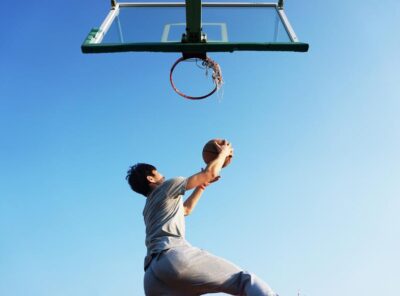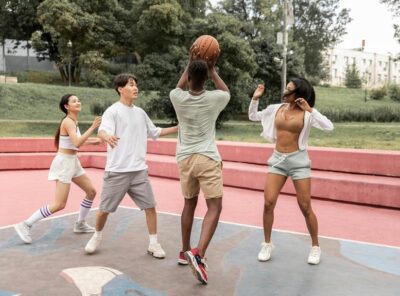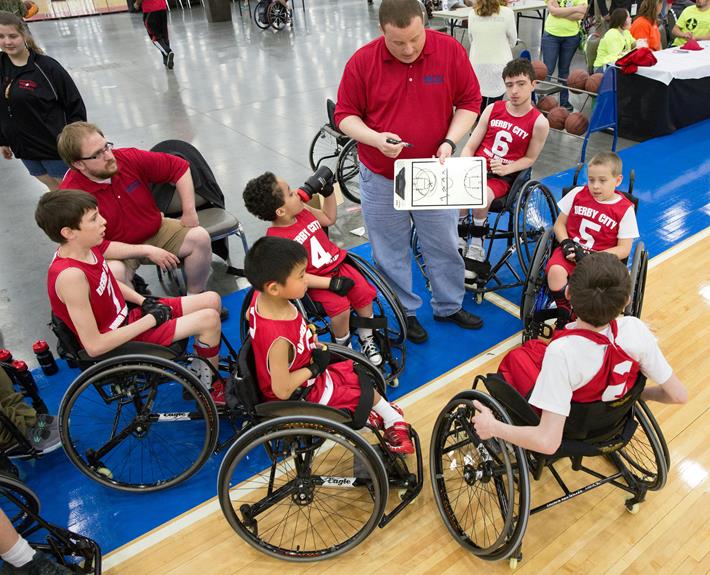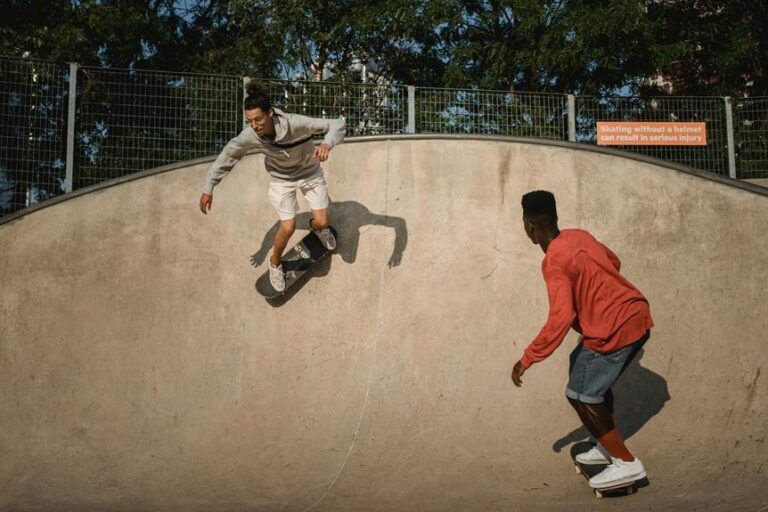What Exercises Enhance Dunking Height?
To boost your dunking height, focus on incorporating lower body strength exercises like squat jumps, Bulgarian split squats, and calf raises. These exercises build power in your legs, essential for explosive jumps.
Plyometric workouts such as squat jumps and jump rope exercises improve explosiveness, while single-leg power training targets individual leg strength and stability, vital for higher jumps.
Core stability exercises like plank variations and balance workouts help improve coordination and balance, enhancing your jumping abilities.
Additionally, cardiovascular conditioning, resistance training, agility drills, flexibility exercises, and proper rest and recovery strategies are key components to enhance your vertical jump and overall dunking capabilities.
Key Takeaways
- Plyometric workouts like squat jumps and depth jumps improve explosiveness for higher jumps.
- Single-leg power training corrects imbalances and enhances stability for increased vertical leap.
- Core stability exercises enhance balance and strength, crucial for maximizing dunking height.
- Cardiovascular conditioning boosts stamina and endurance needed for explosive dunks.
- Resistance training focusing on leg strength, like squats and deadlifts, enhances vertical jump potential.
Lower Body Strength Exercises
To enhance your dunking height, focus on incorporating lower body strength exercises into your training regimen. These exercises are important for building explosive power in your legs, ultimately improving your vertical jump and dunking abilities.
Squat jumps are a necessity, as they target the lower body muscles necessary for generating the force needed to propel yourself upwards. Bulgarian split squats are also essential for working the quads, glutes, and hamstrings, key players in achieving greater height during jumps.
Additionally, calf raises strengthen your calf muscles, which are important for explosive jumps. By including depth jumps into broad jumps, you can combine the benefits of enhancing explosive power and vertical leap.
Consistent resistance training will help you build overall lower body strength and power, directly impacting your dunking height potential.
Plyometric Workouts for Explosiveness
Enhance your explosiveness and vertical jump height with plyometric workouts.
Plyometric exercises like squat jumps and depth jumps are key for developing explosive power essential for achieving higher vertical jumps.
Jump rope exercises can improve foot speed, coordination, and calf strength, all essential for maximizing your jumping ability.
Plyometric push-ups engage your core and enhance coordination, contributing to overall explosive power needed for successful dunking.
Combining depth jumps into broad jumps offers a complete approach to lower body explosive power development.
By incorporating plyometric workouts into your routine, you can greatly improve reactive strength, speed, and explosiveness, ultimately leading to higher jumps and improved dunking ability.
Get ready to soar to new heights by focusing on plyometric exercises to enhance your vertical jump.
Single-Leg Power Training
By focusing on single-leg power training, you can target and strengthen individual leg strength to enhance your vertical jump height.
This type of training is essential for developing explosive power in each leg separately, improving your ability to generate maximum lift during jumps.
Single-leg power training is effective in addressing strength imbalances that may exist between your legs, ultimately enhancing your overall jumping performance. Additionally, by isolating each leg, you can work on improving stability and coordination, leading to more controlled and powerful take-offs.
Incorporating single-leg power exercises into your workout routine allows you to specifically target the muscles required for achieving higher vertical jumps.
Make sure to include these exercises in your training regimen to see improvements in your dunking height.
Core Stability and Balance Exercises
Improving your dunking height requires mastering core stability and balance through targeted exercises that enhance your body control and strength.
Core stability exercises, like plank variations and Russian twists, improve balance crucial for powerful jumps. Balancing on stability balls or using wobble boards strengthens core muscles, aiding stability during explosive movements.
Single-leg exercises, such as single-leg deadlifts and pistol squats, challenge core stability and enhance balance for better dunks. Anti-rotation exercises like Pallof presses help strengthen core muscles, improving balance and control during your jumps.
Unilateral exercises like one-legged squats or single-leg glute bridges are essential for enhancing core stability and preventing injuries while dunking.
| Core Stability Exercises | Single-Leg Exercises | Balance | Anti-Rotation Exercises |
|---|---|---|---|
| Plank variations | Single-leg deadlifts | Balancing on balls | Pallof presses |
| Russian twists | Pistol squats | Wobble boards | |
| One-legged squats | |||
| Single-leg glute bridges |
Cardiovascular Conditioning for Dunking
To boost your dunking performance, focus on enhancing your cardiovascular conditioning for increased stamina and endurance.
Here are some tips to improve your cardio for better dunking abilities:
- Engage in aerobic exercises like running, cycling, or swimming to enhance your overall cardiovascular health and endurance.
- Incorporate high-intensity interval training (HIIT) into your routine to boost cardiovascular fitness and help with quick bursts of energy needed during intense dunks.
- Consistent cardio conditioning not only improves stamina but also contributes to better recovery between intense dunking sessions, allowing you to perform at your best more frequently.
Embrace these cardio workouts to take your dunking skills to new heights!
Resistance Training for Vertical Jump
Improving your vertical jump through focused resistance training is essential for attaining higher dunking height and power. Resistance training, such as squats and deadlifts, builds lower body strength critical for a strong vertical jump.
Incorporating explosive movements like weighted squat jumps can increase muscle power and explosiveness needed for jumping higher. Utilizing progressive overload in your resistance training routine, gradually increasing weight and intensity, is key to seeing continuous improvements in your vertical jump height.
Not only does resistance training strengthen muscles, but it also enhances muscle coordination and neuromuscular efficiency, crucial for maximizing your dunking height potential.
Consistent and structured resistance training routines that target leg strength will lead to significant advancements in your vertical jump over time.
Agility Drills for Athleticism
Improving your athleticism through agility drills is essential for enhancing your overall performance on the court. Agility drills focus on enhancing quickness, coordination, and change of direction abilities important for athletic performance.
To boost your agility and explosiveness, consider incorporating plyometric exercises like box jumps and lateral hops.
These exercises can help increase your footwork speed and overall body control, leading to improved performance in sports like basketball.
Consistent agility training also aids in developing better balance and reaction times, which are important for success on the court.
By dedicating time to agility drills, you can enhance your athleticism, ultimately improving your game and potentially increasing your vertical jump for better dunks.
Flexibility and Mobility Exercises
Enhancing your dunking height starts with incorporating flexibility and mobility exercises into your training regimen.
Flexibility exercises such as dynamic stretching and foam rolling can enhance your range of motion, reducing the risk of injury during explosive movements.
Mobility drills focusing on hip, ankle, and thoracic spine mobility are essential for proper body alignment and maximizing power output in your dunking performance.
By integrating yoga poses like downward dog, pigeon pose, and lizard pose, you can improve overall flexibility, balance, and stability, giving you an edge when going for that slam dunk.
Consistently practicing mobility exercises like hip flexor stretches and shoulder dislocates will refine your body mechanics and optimize your dunking technique.
Utilize resistance bands for dynamic stretching and mobility work to boost joint flexibility, muscle activation, and athletic performance, ultimately enhancing your dunking ability.
Recovery Strategies for Dunking Performance
To optimize your dunking performance, implementing effective recovery strategies is crucial for maintaining muscle health and avoiding injuries. Here are three key strategies to help you recover and enhance your dunking abilities:
- Proper Rest and Recovery: Make sure you get an adequate amount of sleep each night to support muscle recovery and performance improvement.
- Hydration and Nutrition: Stay hydrated and consume a balanced diet rich in nutrients to help your muscles recover and grow stronger.
- Active Recovery: Incorporate light exercises and activities like walking or swimming on rest days to promote blood flow and reduce muscle soreness.
Frequently Asked Questions
How Do You Increase Jump Height for Dunking?
To increase jump height for dunking, focus on plyometric exercises like squat jumps and depth jumps. Incorporate strength training with Bulgarian split squats and calf raises. Enhance balance and stability with targeted exercises. Consistent training is key for improvement.
What Exercises Help You Dunk?
To dunk effectively, focus on exercises like jumping jacks, single-leg deadlifts with jumps, burpees, forward linear jumps, and squat jumps. They enhance strength, stability, agility, and explosive power in your lower body, core, and legs for better dunking height.
How Do You Build Strength for Dunking?
To build strength for dunking, focus on exercises like deep knee bends, squat jumps, deadlifts, and plyometrics. Gradually increase intensity and volume for progress. Remember, consistency and dedication are key to achieving your dunking goals.
What Muscles Do You Train to Dunk?
To dunk effectively, you train important muscles like quadriceps, hamstrings, glutes, and calves. Strengthen these areas with plyometrics, resistance exercises, and explosive movements. Focus on building power and strength for higher jumps.
Conclusion
To sum up, by incorporating a variety of exercises like lower body strength training, plyometrics, single-leg power work, and core stability exercises, you can improve your dunking height.
Don’t forget to include cardiovascular conditioning, resistance training, agility drills, flexibility work, and proper recovery strategies to maximize your performance.
With dedication and consistency, you’ll be soaring to new heights on the court in no time. Keep pushing yourself and reaching for the stars!















